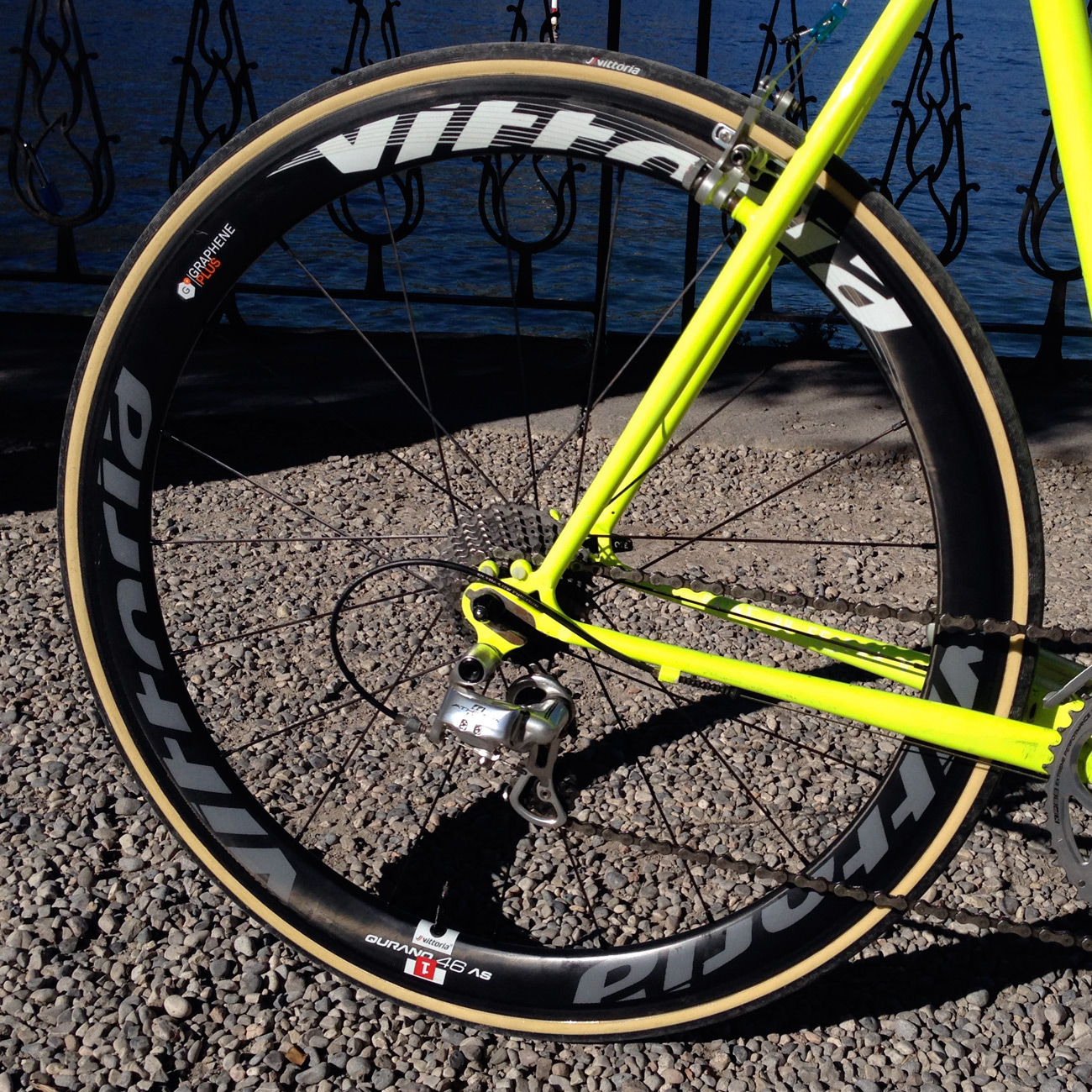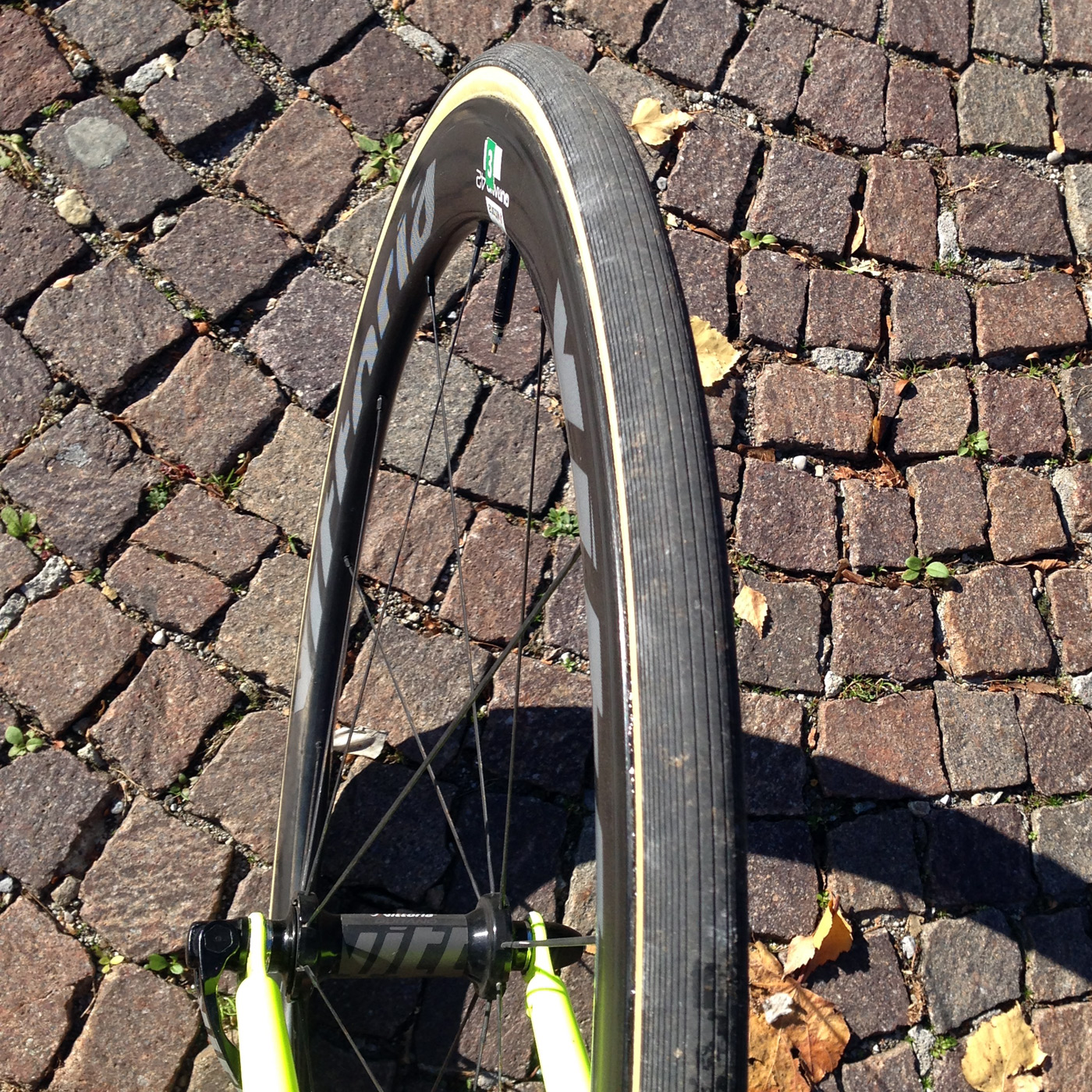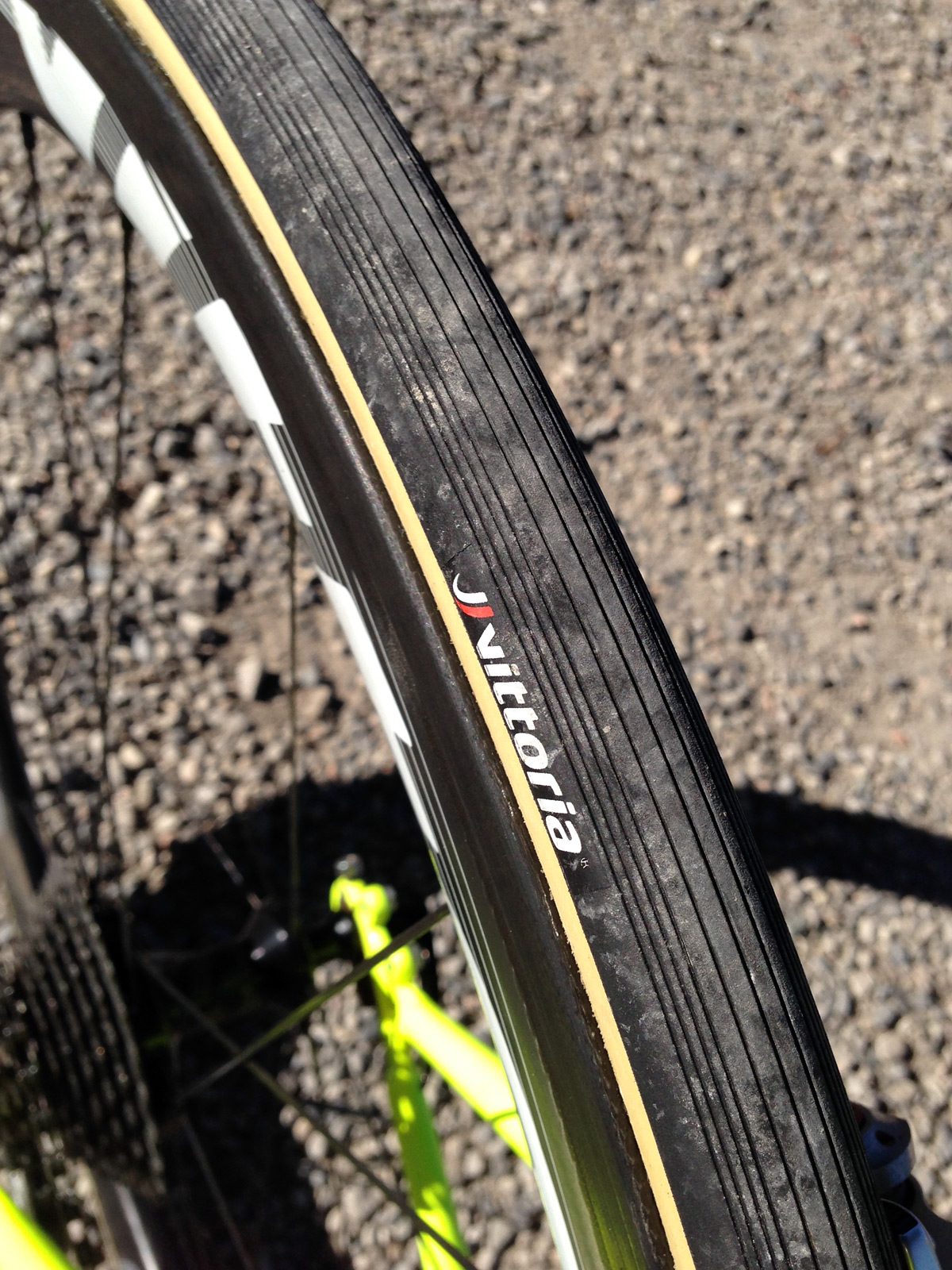We got the unique opportunity to get a day of test riding in with the new Graphene Plus Corsa tubular tires and Qurano 46 carbon wheels from Vittoria on their home turf in the Como region of Italy where the Graphene is produced. Since the tires aren’t yet available to consumers, we were lent a set of wheels from Vittoria’s Service Course with a narrow version of their new all-around competition tubular. As a fairly last-minute affair, we threw our classic steel travel cross bike in its S&S suitcase and set out to put some kms on the setup. Join us after the break for our first impressions of the new tire that will replace both Vittoria’s race Corsa Evo and their classics Pavé CG…
First off, the tires and wheels use Vittoria’s Graphene+ tech that we briefly touched on in our Eurobike coverage, but will expand on more when we get a solid background on what is really going on inside of the graphene-enhanced rubber and carbon. The wheels are a service course version of the Qurano 46, which is actually a 46mm rear rim and 42mm front, both 23mm wide. The rear profile is also dramatically asymmetric for more balanced tension, with the non-driveside rim wall appearing almost flat. The wheels are claimed at just 1298g, and although we didn’t get to weigh them, they certainly feel light both to the touch and on the bike. A nice touch, especially for a light wheelset, they come with a solid set of proper internal cam quick-release skewers.
Vittoria calls the 4-compound, cotton casing Corsa the ‘world’s best tire’, a pretty lofty claim, and offers it in 23, 25 & 28mm widths. The tires we rode didn’t have production labels on them, but they measured just 21mm, leading us to believe that these were an early team-only version (although we were assured that is was all production-level tech.)
Note: Getting back from my ride with our calipers and pumping them up to 10bar/145psi, the tires actually do measure 23mm, so the smaller size was due to lower air pressure creating a less round profile and less precise measurement.
The Corsas had a molded-in label indicating that they were made in Thailand, and are rated to 175psi (and apparently 145psi for the clinchers.) Interestingly, the tires were also glued on with Vittoria’s new Magic Mastik, which we have just started to test in cyclocross.
We won’t debate the functionality of the siped tread, other than to say that it will make it easy to discern when the tire is worn out (and spot which model tire is which.) And this seems like a tire we would be happy to wear out, either in a clincher or tubular. Starting off, while the scenery around Lake Como and the Madonna del Ghisallo is certainly beautiful, the road surfaces are not. Pretty much every other village we rode through had road work going on, and there were an infinite number of potholes, cracked asphalt, and askew grates on our ride. While I would never not often willingly put a 21 23mm tire on my bike (or get near the 12bar these are rated to), these tires were supple enough for me not to care.
Starting off with around 85psi in both tires they were stable, cornered very well, and rolled smoothly over the broken road surface.
Since this tire is replacing the Pavé, we wanted to see how it compared there, so pushing the lower edge of its ideal tire pressure to see how forgiving and flat-resistant it was. The low pressure gave a smooth ride with a low rolling resistance that zipped me along the flats and up the short punchy climbs, even with tired legs from three cross races in the last five days. Besides the rough roads, the short cobblestone sections we encountered on our ride were pretty much buttery smooth (although thankfully the stones were mostly regular with this narrow tire.)
Other than the fact that we would like to spend more time with the wider versions of this tire on a proper mix of asphalt, cobbles, and gravel roads that we know, the tires impressed us as being as capable and smooth as the Pavé, with an even quicker feel (or course subjectively on roads I had never ridden.) They certainly deliver a premium ride quality. Our only problem came in the fact that the latex-tubed tubular loses air ever so slowly as you ride. In the first 3 hours from the start of our ride, we suspect we lost about 5psi in both tires. While that is usually fine in a 25 or 28mm tire, the difference in this little 21 23 meant that I started to feel the rim hit on rough edges in the road and pulled over to add a few pounds of air to the rear only, and had no more issues.
The wheels also did their job well without too much thought. A 1300g set of wheels feels fast no matter what they are, though. And combined with fast-rolling tubulars, we definitely ended up with a higher average speed than we had expected for the ride. The light carbon wheels are certainly not the stiffest we’ve ever ridden, however. On the cross bike which has a good bit of clearance at the brake pads, hard out-of-the-saddle efforts could induce a bit of brake rub out back. Just pulling on the rear wheel at the rim, it was possible to get the rim to deflect to almost touch the brake.
This is possibly due to a hard life the wheelset had already lived serving through a season or two of the Italian spring classics on rough roads as part of Vittoria’s pro tour neutral support. So we will be curious when we get a chance to ride a consumer wheelset to see whether the new production wheels are stiffer.
The symmetric front wheel is noticeably more stiff in the hand, and so I couldn’t induce any front brake rub, even in hard cornering. And together with the stiffer front, the wheels descended very securely and completely predictably coming out of the mountains. The medium depth also likely helped give a little aero nudge, and with only a few windy sections to our ride they never seemed to blow the bike around. As for braking, it was dry so we couldn’t test that, but we did use a different carbon pad than what Vittoria includes/recommends (we talked Vittoria into lending us the wheels for a ride, and didn’t get the stock pads.) So although the braking was predictable and powerful, it was accompanied by some squealing that we hope would be solved with the recommended pads. (We’ve since ridden them with Shimano’s carbon pads, and they were silent, with exceptional braking.)
What we don’t have yet is the detailed science behind what makes the Graphene+ tick, but it is our next step. That is likely what should really push both the tires and rims above the competition if the marketing claims hold water. The wheels claim to lose weight as a result of the Graphene, while retaining durability, getting higher spoke tension, and better heat management. From the tire side, the Graphene claims to lower rolling resistance, increase durability, boost grip, all the while wearing longer. We can’t really test any of those claims until we at least spend a lot more time on the setup, but if the hype is true, the wheels and tires may be in their own class.





